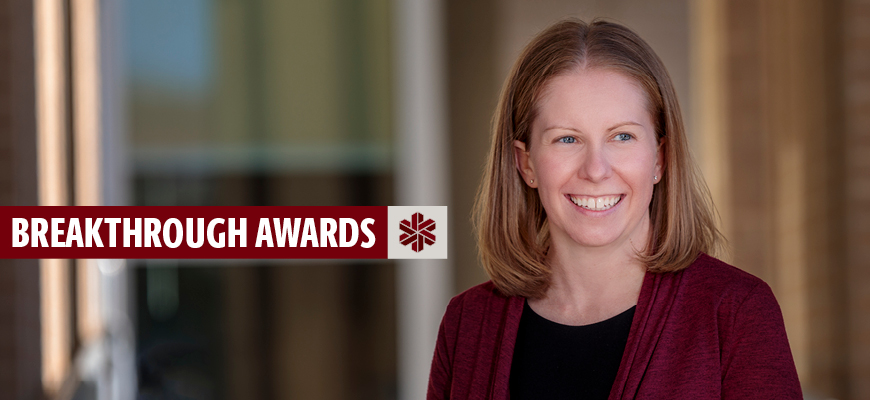
Breakthrough Star: Christine Pellegrini
Exercise physiologist researches new ways to create healthy habits
Posted on: June 20, 2022; Updated on: June 20, 2022
By Megan Sexton, msexton@mailbox.sc.edu, 803-777-1421
Health problems associated with eating too much or moving too little are nothing new. But researcher Christine Pellegrini is using updated techniques and technology to track and try to help change behaviors and improve outcomes.
An exercise physiologist in the Arnold School of Public Health, Pellegrini’s research includes using technology to inform behavioral interventions that target diet, physical activity, sedentary behavior and weight loss in target populations, including people with mobility limitations.
“I've just been fascinated at how challenging it is to change behaviors and then finding a way to use technology to try to make it a little bit easier for people,” she says. “Most of my work focuses on developing different interventions that could be disseminated broadly and reach a lot of people at a lower cost.”
In her research lab, Pellegrini uses devices such as Fitbits to track movement and smartphone apps to track dietary intake as she works to help adults change behaviors for the long haul.
The technology helps to “better intervene in a timely moment,” she says. For example, she uses a smartphone app that tries to predict when people have been sitting for about 30 minutes. When the smartphone detects that there has been no movement, it will send a notification suggesting it would be a good time to get up and stretch.
“Rather than just seeing people once a week or talking to them on the phone and trying to help people reduce their sedentary time that way, we're trying to catch them in the moment. I feel like the technology is allowing us to be more timely about that,” she says. “For our weight loss programs, we use the technology to track diet and physical activity. We know tracking behaviors isn’t people's favorite thing to do, but it's extremely helpful.”
Much of her work focuses on people with mobility limitations, with her most recent study targeting people who have had knee replacement surgery.
I like working with different populations that have different challenges. It's always a new kind of problem to try to solve.
Christine Pellegrini
“We've been catching people right after knee replacement because they go in to have this elective surgery, and unfortunately, a lot of the behaviors are not changing after the surgery. So we're trying to help them increase that physical activity after the surgery,” she says. “And we just started focusing on weight loss recently because many of the adults after knee replacement are actually gaining weight after surgery.”
Pellegrini’s interventions are patient-centered, and she and her team work to get input from the populations they are serving.
“It’s not just me and my team pulling together what we think is going to work. For example, I haven’t had a knee replacement, so I don't know what it is like. So, we pull in people who have had knee replacements and they tell us what they think is important and what we should focus on. And then we run our interventions by them and get their take on it,” she says. “We are really tailoring our programs based on what people in whatever population we're targeting tell us, because they are the ones who know the most.”
Pellegrini says the most rewarding part of her job is helping people see the impact that changing behavior can have on their moods, pain levels and overall health.
“And I like working with different populations that have different challenges,” she says. “It's always a new kind of problem to try to solve.”
Share this Story! Let friends in your social network know what you are reading about